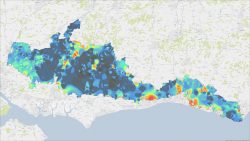South Downs National Park wins International Dark Sky Reserve status
May 10, 2016
The International Dark-Sky Association (IDA) have today, 10 May, named the South Downs National Park as the world’s newest International Dark Sky Reserve.
J. Scott Feierabend, Executive Director of the IDA, said:
“We are pleased to announce the designation of South Downs National Park as an IDA Dark Sky Reserve. It is remarkable that a true dark-sky experience remains within reach of nearly 17 million people in Greater London and southeast England, and a testament to the hard work of South Downs staff and area residents in keeping it that way.”
South Downs Ranger Dark-skies-Dan Oakley and a group of dedicated volunteers have spent the past three years mapping out the quality of night skies across the National Park. The new reserve is the second in England and only the eleventh to be named in the world.

Dan Oakley, South Downs National Park ranger said:
“With the South of England under threat from losing its last few patches of properly dark skies this is a statement that the skies of the South Downs are worth protecting. With 2 million people living within 5 km of the National Park, the reserve will be one of the most accessible in the world and certainly one of the most cared for.”
Plans to create the reserve have received support from more than 70 parish, town and county councils and other organisations with more than 1,300 people signing up to a ‘dark skies pledge’.”
Dr John Mason MBE is Principal Lecturer at the South Downs Planetarium in Chichester. As a founder member of the British Astronomical Association’s Commission for Dark Skies, he has been campaigning for better quality night-time lighting and emphasising the importance of dark night skies for over 25 years:
“This is wonderful news and the culmination of years of hard work by both the SDNPA and many other individuals,” said Dr Mason
“So many young people are growing up in places where the glow of night-time lighting drowns out all but the brightest stars. It is vital that we conserve the dark skies within the South Downs National Park and International Dark Sky Reserve status will help us to do this.
“To me, it is just as important to be able to enjoy a clear, dark, star-studded sky as it is to be able to go on a nice walk in the countryside on a Sunday afternoon.”
Rural Affairs Minister Rory Stewart said:
“This is a wonderful project. A dark night sky – a glimpse of the stars – is both an extraordinary thing, and an increasingly rare experience in a crowded urban world. The South Downs National Park is bringing communities not just an opportunity to see the English countryside at its finest, but also stars far beyond our planet. I’m so pleased that they have brought this project together with such success and confidence.”
Key facts and figures:
• more than 25,000 individual measurements have been taken and used to map sky quality;
• 66 per cent of the South Downs National Park has Bronze* Level skies
• the core boundary of the reserve is 418km2 with 1,104km2 in the peripheral boundary;
• there are approximately 2,700 streetlights in the whole of the National Park. Local lighting authorities have been replacing these over time so that they are now compliant with Dark Sky standards.
The South Downs National Park Authority is one of the largest planning authorities in the country and the emerging Local Plan for the National Park and Parish Neighbourhood Plans include policies to make sure that they will be protected in the future.
Read the full application here
*Gold Level Skies correspond to natural, non-polluted or near-natural night skies; Silver correspond to night-time environments that have minor impacts from light pollution and other artificial light disturbance; and Bronze correspond to areas not meeting the requirements of silver, yet still offering people, plants and animals a respite from an otherwise degraded nocturnal environment.
